A Systematic Review of the Vertical Green System for Balancing Ecology and Urbanity
Abstract
1. Introduction
2. Materials and Methods
2.1. Data Collection
2.2. Bibliometric Methods
3. Bibliometric Insights into Skyrise Greenery Investigations
3.1. Dissecting Authorial Relationships
| Source | Articles Fractionalized | Authors’ Local Impact (m_Index) | Number of Publications | Citation Frequency | Title of the Most Cited Paper |
|---|---|---|---|---|---|
| Jim et al. [24] | 17.87 | 1.571 | 32 | 110 | Biophysical properties and thermal performance of an intensive green roof. |
| Stovin et al. [27] | 6.57 | 1.071 | 19 | 330 | The hydrological performance of a green roof test bed under UK climatic conditions. |
| Irga et al. [25] | 4.38 | 1.714 | 17 | 69 | An assessment of the atmospheric particle removal efficiency of an in-room botanical biofilter system. |
| Rowe et al. [28] | 5.7 | 0.632 | 15 | 388 | Green roofs as a means of pollution abatement. |
| Torpy et al. [26] | 4.38 | 1.714 | 17 | 54 | Green wall technology for the phytoremediation of indoor air: a system for the reduction in high CO2 concentrations. |
| Lundholm et al. [29] | 3.41 | 0.588 | 12 | 217 | Plant species and functional group combinations affect green roof ecosystem functions. |
| Piro et al. [30] | 3.34 | 1.111 | 14 | 19 | Energy and hydraulic performance of a vegetated roof in a sub-Mediterranean climate. |
| Farrell et al. [31] | 2.71 | 0.818 | 12 | 86 | High water users can be drought tolerant: using physiological traits for green roof plant selection. |
| Ma et al. [32] | 2.46 | 1.5 | 13 | 34 | Experimental and numerical investigations on runoff reduction in and water stress of green roofs with varying soil depths and saturated water contents in dry–wet cycles. |
3.2. Pertinent Countries and Their Collaborative Network Dynamics
3.3. Delving into Dominant Research Themes
4. Research on the Regulation of Urban Ecosystem Services by Skyrise Greenery
4.1. Thermal Environment
| Source | Country | Research Content | Research Conclusion | Cluster |
|---|---|---|---|---|
| Klein and Coffman [35] | U.S.A | Radiation balance, air temperature, relative humidity, and buoyancy flux of the green roof were monitored at two weather stations. | The albedo of the green roof was still about twice as high as that of the dark roof surface, and the albedo of gray concrete roof tiles was significantly lower than that often used to simulate the effect of a cold roof. | #0 Heat Flux |
| Saadatian et al. [37] | Malaysia | An overview of the application of green roof strategies. | Discusses various types of green roofs, components of green roofs, economic revenues, and technical attributes, and synthesizes the advantages and disadvantages of green roofs in terms of energy use. | #3 Vegetation Envelope |
| Marçal et al. [38] | Brazil | Thermal sensory perceptions of users of two public squares in the semi-arid region of Paraíba, northeastern Brazil, were observed. | The strong correlation between thermal sensations and measured discomfort indices emphasizes the importance of open spaces, with trees as the most effective way to mitigate heat in urban areas. | #8 Indoor Thermal Environment |
| Zhen and Zou [36] | China | The direct and indirect thermal benefits of growing creepers on buildings in four life stages were evaluated. | Gradually decreasing as the life stage progresses, the cooling gain in the green phase is up to 8 °C and the insulation benefit in the wilting phase is still about 1 °C compared to a concrete wall. | #9 Thermal Performance Measurement |
4.1.1. Green Roofs and Green Walls: Promising Tools for Urban Heat Management
4.1.2. Optimizing the Cooling Capacity of Green Roofs: The Influence of Substrate and Plant Choice
4.2. Urban Hydrological Environment
| Source | Country | Research Content | Research Conclusion | Cluster |
|---|---|---|---|---|
| Peng and Stovin [55] | UK | Study to validate the ability of the stormwater management model (SWMM) module to represent the hydrologic performance of large green roofs in response to actual rainfall events. | The results from the green roof test bed and the SWMM green roof module were compared to demonstrate that the model can represent the hydrology of green roof runoff after calibration. | #1 Pollution Abatement |
| Szota et al. [57] | Australia | Simulated rainfall experiments were conducted on the green roof module to compare the rainfall retention capacity of vegetated and non-vegetated substrates with different WHCs and PAWs, and in relation to substrate storage capacity. | the PAW of the substrate is a better indicator of vaporization and retention than WHC. | #2 Water Supply |
| Pęczkowski et al. [56] | Slovakia | Study of runoff and water quality from the lower Silesian green roof system in the area of the Wroclaw–Slojec agricultural and hydrometeorological station for the period from 2012 to 2016. | The maximum retention performance index calculated for the experimental green surface was as high as 65% relative to rainfall and 49% relative to the control surface (substrate vs. perlite). | #4 Water Retention |
| Stovin et al. [27] | UK | Study investigates the hydrological performance of a full-size, large-area green roof in Leeds, UK. | Green roofs are effective in retaining rainfall from the precipitation events analyzed. | #3 Hydrologic Performance |
4.2.1. Vertical Greenery: An Emerging Approach for Mitigating Rainwater Runoff
4.2.2. Green Roofs and Walls: Nature’s Solution for Urban Water Pollution Control
4.3. The Role of Vertical Green Systems in Enhancing Air Quality
| Source | Country | Research Content | Research Conclusion | Cluster |
|---|---|---|---|---|
| Allen et al. [73] | USA | Simulated indoor environmental quality (IEQ) conditions in “Green” and “Conventional” buildings and evaluated the impacts on an objective measure of human performance: higher-order cognitive function. | On average, cognitive scores were 61% higher on the green building day and 101% higher on the two Green+ building days than on the conventional building day (p < 0.0001). VOC and CO2 were independently associated with cognitive scores. | #0 Indoor Environment |
| Pettit et al. [74] | Australia | Assessed the capacity of replicate active green walls to filter NO2 at both ambient temperatures. | Consider active green walls (i.e., VOC filtration, PM filtration, CO2 reduction, enhanced humidity and temperature, and biophilic benefits) as phytoremediation agents for a limited number of pollutants. | #5 Volatile Organic Compounds |
| Abdo et al. [75] | Australia | A detailed assessment of airflow through an active green wall module. | More air will pass through a typical green wall substrate, and hence become cleansed, when the substrate is saturated more than when it is dry. | #6 Active Green Wall |
| Patton et al. [76] | USA | Evaluated effects of ventilation, occupant behaviors, and overall building design on PM mass concentrations. | The building design and occupant behaviors that either produce or dilute indoor PM are important factors affecting residents’ exposure to PM in residential green buildings. | #2 Green Plants |
4.3.1. Green Roof and Green Walls Act as Natural Air Filters
4.3.2. Optimize Green Roofs and Green Walls to Absorb Pollutants: Plant Selection
4.4. Regulation of Other Ecosystem Services
5. Future Research Prospects and Conclusions
- (1)
- Bibliometric investigations reveal that some knowledge gaps remain in the performance metrics of skyrise greenery under evolving climatic and hydrological paradigms, resulting from fast urbanization processes. Alterations in land utilization and climatic dynamics can pivot urban green space planning. Furthermore, although previous studies indicated that green roofs are an effective means for mitigating the urban heat island effect, the application of model simulation for elucidating the heat transport mechanisms associated with roof material, plant-growing substrates, vegetation species, and soil microbial community still remains scarce. Moreover, the design of innovative vertical green systems should be tailored on account of individual cooling or insulation performances. In addition, the quantification of energy saving and cost effectiveness should be considered along with their ecological benefits for regulating the thermal environment.
- (2)
- With multiple environmental benefits, vertical greenery has been proved to be a promising approach for stormwater management. However, the lack of consistency on previous research results on the assessment of the environmental impact of leachate from green roofs on receiving waters has generated unfavorable views. As such, themes such as the (lack of) consideration of the use of fertilizers on green roofs and the assessment of the sour-sink effect, may lead to ambiguous conclusions and misinterpretations. Furthermore, designing verdant facades and green roofs necessitates a holistic evaluation of stormwater management functionalities. To maximize the significant role of greenery in reducing stormwater runoff and enhancing water quality, the combination of different components in vertical green systems should be optimized, such as vegetation species, soil substrates, and microbial structure.
- (3)
- In addition to technological perspectives, the conceptualization and formulation of skyrise greenery also mandates a contemplation of the societal, economic, and public health dimensions. Bibliometric outcomes accentuate the imperative for enriched research in this domain. For instance, when subjected to skyrise greenery design, the Life Cycle Assessment (LCA) and Life Cycle Cost Analysis (LCCA) should be considered for better understanding the holistic economic and ecological footprints of such systems. As such, fiscal interventions or incentives may be a requisite for such implementations. Sociologically, enhancing the perceptions and public participation in relation to skyscraper greening projects are also necessary. Future studies should be conducted based on an interdisciplinary approach, taking social, economic, engineering, and ecological aspects into overall consideration.
- (4)
- Future deliberations should explore the influence of legislative frameworks and governance edifices on the facilitation or impediment of skyrise greenery implementations. This entails the creation of malleable policies and regulations to buttress Green Stormwater Infrastructure (GSI), as well as formulate policy incentives to foster GSI adoption. Using Singapore as a case study, a profound national policy supporting skyrise greenery implementation is conducive to optimizing GSI’s holistic dividends.
- (5)
- Skyrise greenery harbors latent potential for urban biodiversity conservation and air pollutant mitigation. Incorporating principles of landscape ecology into skyrise greenery can attenuate air pollution while amplifying urban biodiversity. However, value assessments for vertical green systems often ignore the trade-offs and complementarity between different services. In addition, given the severe impacts of climate change induced by greenhouse emissions, the significant contribution of plants to CO2 mitigation and sequestration through photosynthesis should be identified in future research.
Author Contributions
Funding
Data Availability Statement
Conflicts of Interest
References
- Shushunova, N.; Korol, E.; Luzay, E.; Shafieva, D.; Bevilacqua, P. Ensuring the Safety of Buildings by Reducing the Noise Impact through the Use of Green Wall Systems. Energies 2022, 15, 8097. [Google Scholar] [CrossRef]
- Lagarias, A. Urban sprawl simulation linking macro-scale processes to micro-dynamics through cellular automata, an application in Thessaloniki, Greece. Appl. Geogr. 2012, 34, 146–160. [Google Scholar] [CrossRef]
- Liu, X.; Liang, X.; Li, X.; Xu, X.; Ou, J.; Chen, Y.; Li, S.; Wang, S.; Pei, F. A future land use simulation model (FLUS) for simulating multiple land use scenarios by coupling human and natural effects. Landsc. Urban Plann. 2017, 168, 94–116. [Google Scholar] [CrossRef]
- Benoit, A.; Johnston, T.; MacLachlan, I.; Ramsey, D. Identifying ranching landscape values in the Calgary, Alberta region: Implications for land-use planning. Can. Geographer. 2018, 62, 212–224. [Google Scholar] [CrossRef]
- Grêt-Regamey, A.; Galleguillos-Torres, M.; Dissegna, A.; Weibel, B. How urban densification influences ecosystem services—A comparison between a temperate and a tropical city. Environ. Res. Lett. 2020, 15, 075001. [Google Scholar] [CrossRef]
- Dahanayake, K.; Chow, C. Comparing reduction of building cooling load through green roofs and green walls by EnergyPlus simulations. Build. Simul. 2018, 11, 421–434. [Google Scholar] [CrossRef]
- Zhang, S.; Muñoz Ramírez, F. Assessing and mapping ecosystem services to support urban green infrastructure: The case of Barcelona, Spain. Cities 2019, 92, 59–70. [Google Scholar] [CrossRef]
- Koh, N.S.; Hahn, T.; Ituarte-Lima, C. Safeguards for enhancing ecological compensation in Sweden. Land Use Policy 2017, 64, 186–199. [Google Scholar] [CrossRef]
- Su, J.; Wang, M.; Razi, M.A.; Dom, N.M.; Sulaiman, N.; Tan, L.-W. A Bibliometric Review of Nature-Based Solutions on Urban Stormwater Management. Sustainability 2023, 15, 7281. [Google Scholar] [CrossRef]
- Gałecka-Drozda, A.; Wilkaniec, A.; Szczepańska, M.; Świerk, D. Potential nature-based solutions and greenwashing to generate green spaces: Developers’ claims versus reality in new housing offers. Urban For. Urban Green. 2021, 65, 127345. [Google Scholar] [CrossRef]
- Douglas, A.N.J.; Morgan, A.L.; Rogers, E.I.E.; Irga, P.J.; Torpy, F.R. Evaluating and comparing the green wall retrofit suitability across major Australian cities. J. Environ. Manag. 2021, 298, 113417. [Google Scholar] [CrossRef] [PubMed]
- Wang, P.; Wong, Y.H.; Tan, C.Y.; Li, S.; Chong, W.T. Vertical Greening Systems: Technological Benefits, Progresses and Prospects. Sustainability 2022, 14, 2997. [Google Scholar] [CrossRef]
- Pradhan, S.; Al-Ghamdi, S.G.; Mackey, H.R. Greywater recycling in buildings using living walls and green roofs: A review of the applicability and challenges. Sci. Total Environ. 2019, 652, 330–344. [Google Scholar] [CrossRef] [PubMed]
- Manso, M.; Teotónio, I.; Silva, C.M.; Cruz, C.O. Green roof and green wall benefits and costs: A review of the quantitative evidence. Renew. Sustain. Energy Rev. 2021, 135, 110111. [Google Scholar] [CrossRef]
- Teotónio, I.; Silva, C.M.; Cruz, C.O. Economics of green roofs and green walls: A literature review. Sustain. Cities Soc. 2021, 69, 102781. [Google Scholar] [CrossRef]
- Ávila-Hernández, A.; Simá, E.; Ché-Pan, M. Research and development of green roofs and green walls in Mexico: A review. Sci. Total Environ. 2023, 856, 158978. [Google Scholar] [CrossRef] [PubMed]
- Cheshmehzangi, A.; Butters, C.; Xie, L.; Dawodu, A. Green infrastructures for urban sustainability: Issues, implications, and solutions for underdeveloped areas. Urban For. Urban Green. 2021, 59, 127028. [Google Scholar] [CrossRef]
- Ying, J.; Zhang, X.; Zhang, Y.; Bilan, S. Green infrastructure: Systematic literature review. Econ. Res.-Ekon. Istraživanja. 2021, 35, 343–366. [Google Scholar] [CrossRef]
- Aria, M.; Cuccurullo, C. bibliometrix: An R-tool for comprehensive science mapping analysis. J. Informetr. 2017, 11, 959–975. [Google Scholar] [CrossRef]
- Chen, T.; Wang, M.; Su, J.; Li, J. Unlocking the Positive Impact of Bio-Swales on Hydrology, Water Quality, and Biodiversity: A Bibliometric Review. Sustainability 2023, 15, 8141. [Google Scholar] [CrossRef]
- Meyer, M.; Grant, K.; Morlacchi, P.; Weckowska, D. Triple Helix indicators as an emergent area of enquiry: A bibliometric perspective. Scientometrics 2014, 99, 151–174. [Google Scholar] [CrossRef]
- Mukherjee, D.; Lim, W.M.; Kumar, S.; Donthu, N. Guidelines for advancing theory and practice through bibliometric research. J. Bus. Res. 2022, 148, 101–115. [Google Scholar] [CrossRef]
- Manoli, G.; Fatichi, S.; Schläpfer, M.; Yu, K.; Crowther, T.W.; Meili, N.; Burlando, P.; Katul, G.G.; Bou-Zeid, E. Magnitude of urban heat islands largely explained by climate and population. Nature 2019, 573, 55–60. [Google Scholar] [CrossRef] [PubMed]
- Jim, C.Y.; Tsang, S.W. Biophysical properties and thermal performance of an intensive green roof. Build. Environ. 2011, 46, 1263–1274. [Google Scholar] [CrossRef]
- Irga, P.J.; Paull, N.J.; Abdo, P.; Torpy, F.R. An assessment of the atmospheric particle removal efficiency of an in-room botanical biofilter system. Build. Environ. 2017, 115, 281–290. [Google Scholar] [CrossRef]
- Torpy, F.; Zavattaro, M.; Irga, P. Green wall technology for the phytoremediation of indoor air: A system for the reduction of high CO2 concentrations. Air Qual. Atous. Health 2017, 10, 575–585. [Google Scholar] [CrossRef]
- Stovin, V.; Vesuviano, G.; Kasmin, H. The hydrological performance of a green roof test bed under UK climatic conditions. J. Hydrol. 2012, 414–415, 148–161. [Google Scholar] [CrossRef]
- Rowe, D.B. Green roofs as a means of pollution abatement. Environ. Pollut. 2011, 159, 2100–2110. [Google Scholar] [CrossRef] [PubMed]
- Lundholm, J.; MacIvor, J.S.; MacDougall, Z.; Ranalli, M. Plant Species and Functional Group Combinations Affect Green Roof Ecosystem Functions. PLoS ONE 2010, 5, e9677. [Google Scholar] [CrossRef]
- Piro, P.; Carbone, M.; De Simone, M.; Maiolo, M.; Bevilacqua, P.; Arcuri, N. Energy and Hydraulic Performance of a Vegetated Roof in Sub-Mediterranean Climate. Sustainability 2018, 10, 3473. [Google Scholar] [CrossRef]
- Farrell, C.; Szota, C.; Williams, N.S.G.; Arndt, S.K. High water users can be drought tolerant: Using physiological traits for green roof plant selection. Plant Soil. 2013, 372, 177–193. [Google Scholar] [CrossRef]
- Ma, M.; Wang, J.; Garg, A.; Mei, G.X. Experimental and numerical investigation on runoff reduction and water stress of green roofs with varying soil depth and saturated water content under dry-wet cycles. Acta Geophys. 2023, 71, 893–903. [Google Scholar] [CrossRef]
- Zhuang, Y.; Jo, H. To Predict the Tendency of the Development of Urban Comprehensive Park through the Social Reform of China—The Example of Changes of Comprehensive Park in Wuhan City. Int. J. Environ. Sci. Technol. 2015, 24, 1155–1161. [Google Scholar] [CrossRef]
- Zölch, T.; Maderspacher, J.; Wamsler, C.; Pauleit, S. Using green infrastructure for urban climate-proofing: An evaluation of heat mitigation measures at the micro-scale. Urban For. Urban Green. 2016, 20, 305–316. [Google Scholar] [CrossRef]
- Klein, P.M.; Coffman, R. Establishment and performance of an experimental green roof under extreme climatic conditions. Sci. Total Environ. 2015, 512–513, 82–93. [Google Scholar] [CrossRef]
- Zhen, M.; Zou, W. Thermal effects of vertical greening with creepers in different life stages on the outdoor environment under a cold climate. Environ. Sci. Pollut. Res. 2023, 30, 5774–5790. [Google Scholar] [CrossRef]
- Saadatian, O.; Sopian, K.; Salleh, E.; Lim, C.H.; Riffat, S.; Saadatian, E.; Toudeshki, A.; Sulaiman, M.Y. A review of energy aspects of green roofs. Renew. Sust. Energ. Rev. 2013, 23, 155–168. [Google Scholar] [CrossRef]
- Marçal, N.A.; da Silva, R.M.; Santos, C.A.G.; Santos, J.S.D. Analysis of the environmental thermal comfort conditions in public squares in the semiarid region of northeastern Brazil. Build. Environ. 2019, 152, 145–159. [Google Scholar] [CrossRef]
- Mayrand, F.; Clergeau, P. Green Roofs and Green Walls for Biodiversity Conservation: A Contribution to Urban Connectivity? Sustainability 2018, 10, 985. [Google Scholar] [CrossRef]
- Feng, H.; Hewage, K. Energy saving performance of green vegetation on LEED certified buildings. Energy Build. 2014, 75, 281–289. [Google Scholar] [CrossRef]
- Mazzali, U.; Peron, F.; Romagnoni, P.; Pulselli, R.M.; Bastianoni, S. Experimental investigation on the energy performance of Living Walls in a temperate climate. Build. Environ. 2013, 64, 57–66. [Google Scholar] [CrossRef]
- Vox, G.; Blanco, I.; Schettini, E. Green façades to control wall surface temperature in buildings. Build. Environ. 2018, 129, 154–166. [Google Scholar] [CrossRef]
- Fioretti, R.; Palla, A.; Lanza, L.G.; Principi, P. Green roof energy and water related performance in the Mediterranean climate. Build. Environ. 2010, 45, 1890–1904. [Google Scholar] [CrossRef]
- Pragati, S.; Shanthi Priya, R.; Pradeepa, C.; Senthil, R. Simulation of the Energy Performance of a Building with Green Roofs and Green Walls in a Tropical Climate. Sustainability 2023, 15, 2006. [Google Scholar] [CrossRef]
- Yang, Y.; Hu, K.; Liu, Y.; Wang, Z.; Dong, K.; Lv, P.; Shi, X. Optimisation of Building Green Performances Using Vertical Greening Systems: A Case Study in Changzhou, China. Sustainability 2023, 15, 4494. [Google Scholar] [CrossRef]
- Cameron, R.W.F.; Taylor, J.E.; Emmett, M.R. What’s ‘cool’ in the world of green façades? How plant choice influences the cooling properties of green walls. Build. Environ. 2014, 73, 198–207. [Google Scholar] [CrossRef]
- Akbari, H.; Kolokotsa, D. Three decades of urban heat islands and mitigation technologies research. Energy Build. 2016, 133, 834–842. [Google Scholar] [CrossRef]
- Sternberg, T.; Viles, H.; Cathersides, A. Evaluating the role of ivy (Hedera helix) in moderating wall surface microclimates and contributing to the bioprotection of historic buildings. Build. Environ. 2011, 46, 293–297. [Google Scholar] [CrossRef]
- Permpituck, S.; Namprakai, P. The energy consumption performance of roof lawn gardens in Thailand. Renew. Energy 2012, 40, 98–103. [Google Scholar] [CrossRef]
- Tabares-Velasco, P.C.; Srebric, J. Experimental quantification of heat and mass transfer process through vegetated roof samples in a new laboratory setup. Int. J. Heat Mass Transfer. 2011, 54, 5149–5162. [Google Scholar] [CrossRef]
- Pérez, G.; Coma, J.; Martorell, I.; Cabeza, L.F. Vertical Greenery Systems (VGS) for energy saving in buildings: A review. Renew. Sust. Energy. Rev. 2014, 39, 139–165. [Google Scholar] [CrossRef]
- Tsang, S.W.; Jim, C.Y. Theoretical evaluation of thermal and energy performance of tropical green roofs. Energy 2011, 36, 3590–3598. [Google Scholar] [CrossRef]
- Vijayaraghavan, K. Green roofs: A critical review on the role of components, benefits, limitations and trends. Renew. Sust. Energ. Rev. 2016, 57, 740–752. [Google Scholar] [CrossRef]
- Wang, M.; Liu, M.; Zhang, D.; Qi, J.; Fu, W.; Zhang, Y.; Rao, Q.; Amin, E.B.; Soon, K.T. Assessing and optimizing the hydrological performance of Grey-Green infrastructure systems in response to climate change and non-stationary time series. Water Res. 2023, 232, 119720. [Google Scholar] [CrossRef]
- Stovin, V.; Peng, Z. Independent Validation of the SWMM Green Roof Module. J. Hydrol. Eng. 2017, 22, 04017037. [Google Scholar] [CrossRef]
- Pęczkowski, G.; Szawernoga, K.; Kowalczyk, T.; Orzepowski, W.; Pokładek, R. Runoff and Water Quality in the Aspect of Environmental Impact Assessment of Experimental Area of Green Roofs in Lower Silesia. Sustainability 2020, 12, 4793. [Google Scholar] [CrossRef]
- Szota, C.; Fletcher, T.D.; Desbois, C.; Rayner, J.P.; Williams, N.S.G.; Farrell, C. Laboratory Tests of Substrate Physical Properties May Not Represent the Retention Capacity of Green Roof Substrates. Water 2017, 9, 920. [Google Scholar] [CrossRef]
- Kuoppamäki, K. Vegetated roofs for managing stormwater quantity in cold climate. Ecol. Eng. 2021, 171, 106388. [Google Scholar] [CrossRef]
- Gregoire, B.G.; Clausen, J.C. Effect of a modular extensive green roof on stormwater runoff and water quality. Ecol. Eng. 2011, 37, 963–969. [Google Scholar] [CrossRef]
- Palla, A.; Gnecco, I.; Lanza, L.G. Compared performance of a conceptual and a mechanistic hydrologic models of a green roof. Hydrol. Process. 2012, 26, 73–84. [Google Scholar] [CrossRef]
- Ouldboukhitine, S.E.; Belarbi, R.; Sailor, D.J. Experimental and numerical investigation of urban street canyons to evaluate the impact of green roof inside and outside buildings. Appl. Energy. 2014, 114, 273–282. [Google Scholar] [CrossRef]
- Morakinyo, T.E.; Dahanayake, K.; Ng, E.; Chow, C.L. Temperature and cooling demand reduction by green-roof types in different climates and urban densities: A co-simulation parametric study. Energy Build.. 2017, 145, 226–237. [Google Scholar] [CrossRef]
- Paull, N.J.; Irga, P.J.; Torpy, F.R. Active green wall plant health tolerance to diesel smoke exposure. Environ. Pollut. 2018, 240, 448–456. [Google Scholar] [CrossRef] [PubMed]
- Besir, A.B.; Cuce, E. Green roofs and facades: A comprehensive review. Renew. Sust. Energ. Rev. 2018, 82, 915–939. [Google Scholar] [CrossRef]
- Yuan, H.; Wang, M.; Li, J.; Zhang, D.; Rana, M.A.I.; Su, J.; Zhou, S.; Wang, Y.; Zhang, Q. Matrix scenario-based urban flooding damage prediction via convolutional neural network. J. Environ. Manag. 2024, 349, 119470. [Google Scholar] [CrossRef]
- Taebi, A.; Droste, R.L. Pollution loads in urban runoff and sanitary wastewater. Sci. Total Environ. 2004, 327, 175–184. [Google Scholar] [CrossRef] [PubMed]
- Ling, N.; Wang, T.; Kuzyakov, Y. Rhizosphere bacteriome structure and functions. Nat. Commun. 2022, 13, 836. [Google Scholar] [CrossRef]
- Liu, Y.; Bralts, V.F.; Engel, B.A. Evaluating the effectiveness of management practices on hydrology and water quality at watershed scale with a rainfall-runoff model. Sci. Total Environ. 2015, 511, 298–308. [Google Scholar] [CrossRef] [PubMed]
- Barron, N.J.; Deletic, A.; Jung, J.; Fowdar, H.; Chen, Y.; Hatt, B.E. Dual-mode stormwater-greywater biofilters: The impact of alternating water sources on treatment performance. Water Res. 2019, 159, 521–537. [Google Scholar] [CrossRef]
- Monterusso, M.; Rowe, D.; Rugh, C.; Russell, D. Runoff water quantity and quality from green roof systems. In Proceedings of the XXVI International Horticultural Congress: Expanding Roles for Horticulture in Improving Human Well-Being and Life Quality, Toronto, ON, Canada, 11–17 August 2002; Volume 639, pp. 369–376. [Google Scholar]
- Harper, G.E.; Limmer, M.A.; Showalter, W.E.; Burken, J.G. Nine-month evaluation of runoff quality and quantity from an experiential green roof in Missouri, USA. Ecol. Eng. 2015, 78, 127–133. [Google Scholar] [CrossRef]
- Liu, H.; Kong, F.; Yin, H.; Middel, A.; Zheng, X.; Huang, J.; Xu, H.; Wang, D.; Wen, Z. Impacts of green roofs on water, temperature, and air quality: A bibliometric review. Build. Environ. 2021, 196, 107794. [Google Scholar] [CrossRef]
- Allen, J.G.; MacNaughton, P.; Satish, U.; Santanam, S.; Vallarino, J.; Spengler, J.D. Associations of Cognitive Function Scores with Carbon Dioxide, Ventilation, and Volatile Organic Compound Exposures in Office Workers: A Controlled Exposure Study of Green and Conventional Office Environments. Environ. Health Perspect. 2016, 124, 805–812. [Google Scholar] [CrossRef] [PubMed]
- Pettit, T.; Irga, P.; Surawski, N.; Torpy, F. An Assessment of the Suitability of Active Green Walls for NO2 Reduction in Green Buildings Using a Closed-Loop Flow Reactor. Atmosphere 2019, 10, 801. [Google Scholar] [CrossRef]
- Abdo, P.; Huynh, B.P.; Irga, P.J.; Torpy, F.R. Evaluation of air flow through an active green wall biofilter. Urban For. Urban Green. 2019, 41, 75–84. [Google Scholar] [CrossRef]
- Patton, A.P.; Calderon, L.; Xiong, Y.; Wang, Z.; Senick, J.; Sorensen Allacci, M.; Plotnik, D.; Wener, R.; Andrews, C.J.; Krogmann, U.; et al. Airborne Particulate Matter in Two Multi-Family Green Buildings: Concentrations and Effect of Ventilation and Occupant Behavior. Int. J. Environ. Res. Public Health 2016, 13, 144. [Google Scholar] [CrossRef]
- Ghazalli, A.J.; Brack, C.; Bai, X.; Said, I. Alterations in use of space, air quality, temperature and humidity by the presence of vertical greenery system in a building corridor. Urban For. Urban Green. 2018, 32, 177–184. [Google Scholar] [CrossRef]
- Baraldi, R.; Neri, L.; Costa, F.; Facini, O.; Rapparini, F.; Carriero, G. Ecophysiological and micromorphological characterization of green roof vegetation for urban mitigation. Urban For. Urban Green. 2019, 37, 24–32. [Google Scholar] [CrossRef]
- Viecco, M.; Vera, S.; Jorquera, H.; Bustamante, W.; Gironás, J.; Dobbs, C.; Leiva, E. Potential of Particle Matter Dry Deposition on Green Roofs and Living Walls Vegetation for Mitigating Urban Atmospheric Pollution in Semiarid Climates. Sustainability 2018, 10, 2431. [Google Scholar] [CrossRef]
- Weerakkody, U.; Dover, J.W.; Mitchell, P.; Reiling, K. Particulate matter pollution capture by leaves of seventeen living wall species with special reference to rail-traffic at a metropolitan station. Urban For. Urban Green. 2017, 27, 173–186. [Google Scholar] [CrossRef]
- Safikhani, T.; Abdullah, A.M.; Ossen, D.R.; Baharvand, M. A review of energy characteristic of vertical greenery systems. J. Renew. Sustain. Energy 2014, 40, 450–462. [Google Scholar] [CrossRef]
- Han, D.; Shen, H.; Duan, W.; Chen, L. A review on particulate matter removal capacity by urban forests at different scales. Urban For. Urban Green. 2020, 48, 126565. [Google Scholar] [CrossRef]
- Luck, G.; Chan, K.; Fay, J. Protecting ecosystem services and biodiversity in the world’s watersheds. Conserv. Lett. 2009, 2, 179–188. [Google Scholar] [CrossRef]
- Kooloth Valappil, A.; Kumar, P.; Gallagher, J.; McNabola, A.; Baldauf, R.; Pilla, F.; Broderick, B.; Di Sabatino, S.; Pulvirenti, B. Air Pollution Abatement Performances of Green Infrastructure in Open Road and Built-up Street Canyon Environments—A Review. Atmos. Environ. 2017, 162, 71–86. [Google Scholar] [CrossRef]
- Berardi, U.; GhaffarianHoseini, A.; GhaffarianHoseini, A. State-of-the-art analysis of the environmental benefits of green roofs. Appl. Energy. 2014, 115, 411–428. [Google Scholar] [CrossRef]
- Dzierzanowski, K.; Popek, R.; Gawrońska, H.; Saebø, A.; Gawroński, S.W. Deposition of particulate matter of different size fractions on leaf surfaces and in waxes of urban forest species. Int. J. Phytorem. 2011, 13, 1037–1046. [Google Scholar] [CrossRef] [PubMed]
- Iligan, R.; Irga, P. Are green wall technologies suitable for major transport infrastructure construction projects? Urban For. Urban Green. 2021, 65, 127313. [Google Scholar] [CrossRef]
- Song, Y.; Maher, B.A.; Li, F.; Wang, X.; Sun, X.; Zhang, H. Particulate matter deposited on leaf of five evergreen species in Beijing, China: Source identification and size distribution. Atmos. Environ. 2015, 105, 53–60. [Google Scholar] [CrossRef]
- Van Renterghem, T.; Botteldooren, D.; Verheyen, K. Road traffic noise shielding by vegetation belts of limited depth. J. Sound Vib. 2012, 331, 2404–2425. [Google Scholar] [CrossRef]
- Jaafar, B.; Said, I.; Reba, M.N.M.; Rasidi, M.H. Impact of Vertical Greenery System on Internal Building Corridors in the Tropic. Procedia—Soc. Behav. Sci. 2013, 105, 558–568. [Google Scholar] [CrossRef]
- Greg, P.; Moritz, V.D.L.; Ingo, K. Untangling the role of urban ecosystems as habitats for endangered plant species. Landsc. Urban Plann. 2019, 189, 320–334. [Google Scholar] [CrossRef]
- Wooster, E.I.F.; Fleck, R.; Torpy, F.; Ramp, D.; Irga, P.J. Urban green roofs promote metropolitan biodiversity: A comparative case study. Build. Environ. 2022, 207, 108458. [Google Scholar] [CrossRef]
- Hostetler, M.; Allen, W.; Meurk, C. Conserving urban biodiversity? Creating green infrastructure is only the first step. Landscape Urban Plann. 2011, 100, 369–371. [Google Scholar] [CrossRef]
- Wang, M.; Sun, C.; Zhang, D. Opportunities and challenges in green stormwater infrastructure (GSI): A comprehensive and bibliometric review of ecosystem services from 2000 to 2021. Environ. Res. 2023, 236, 116701. [Google Scholar] [CrossRef] [PubMed]
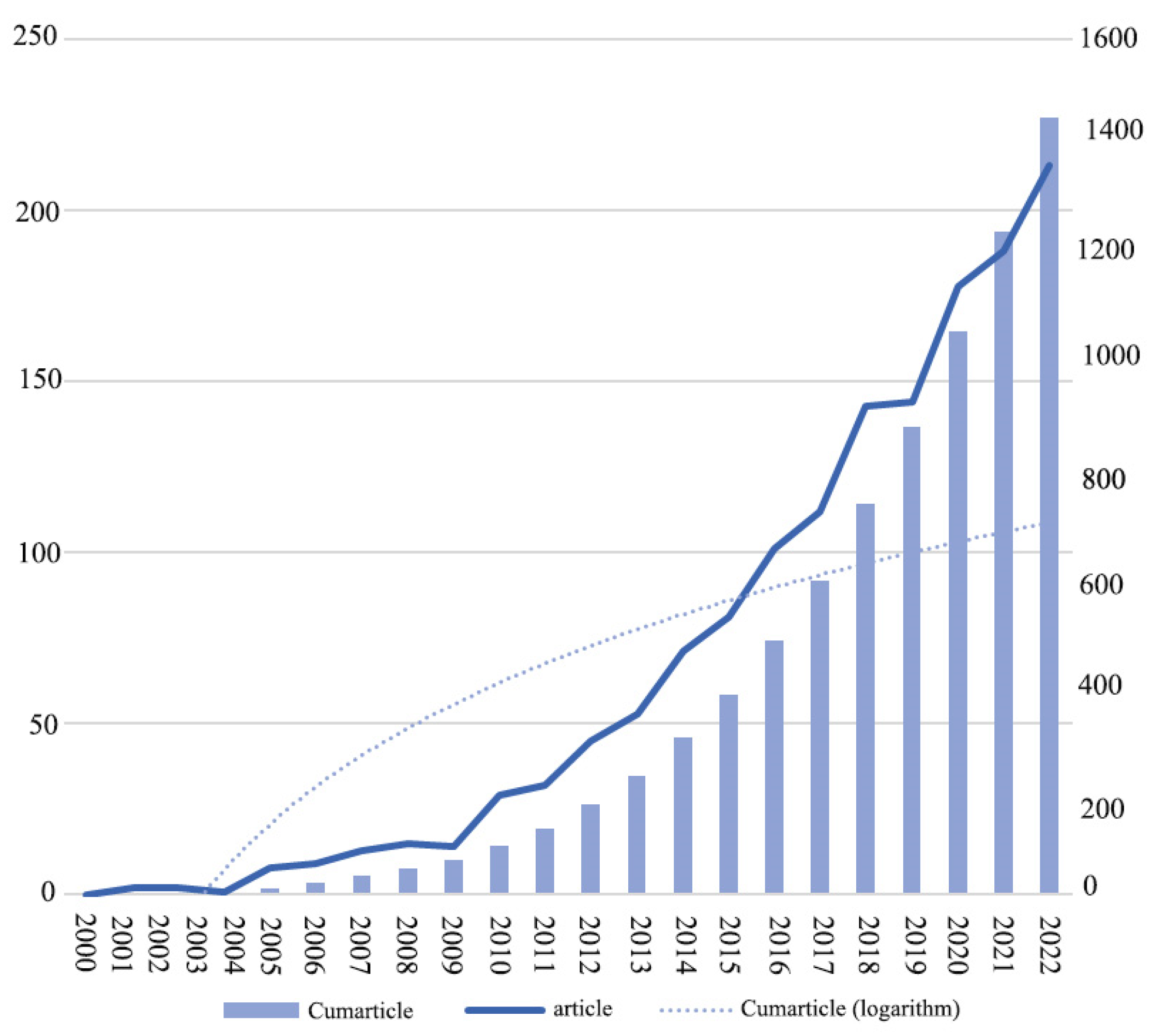
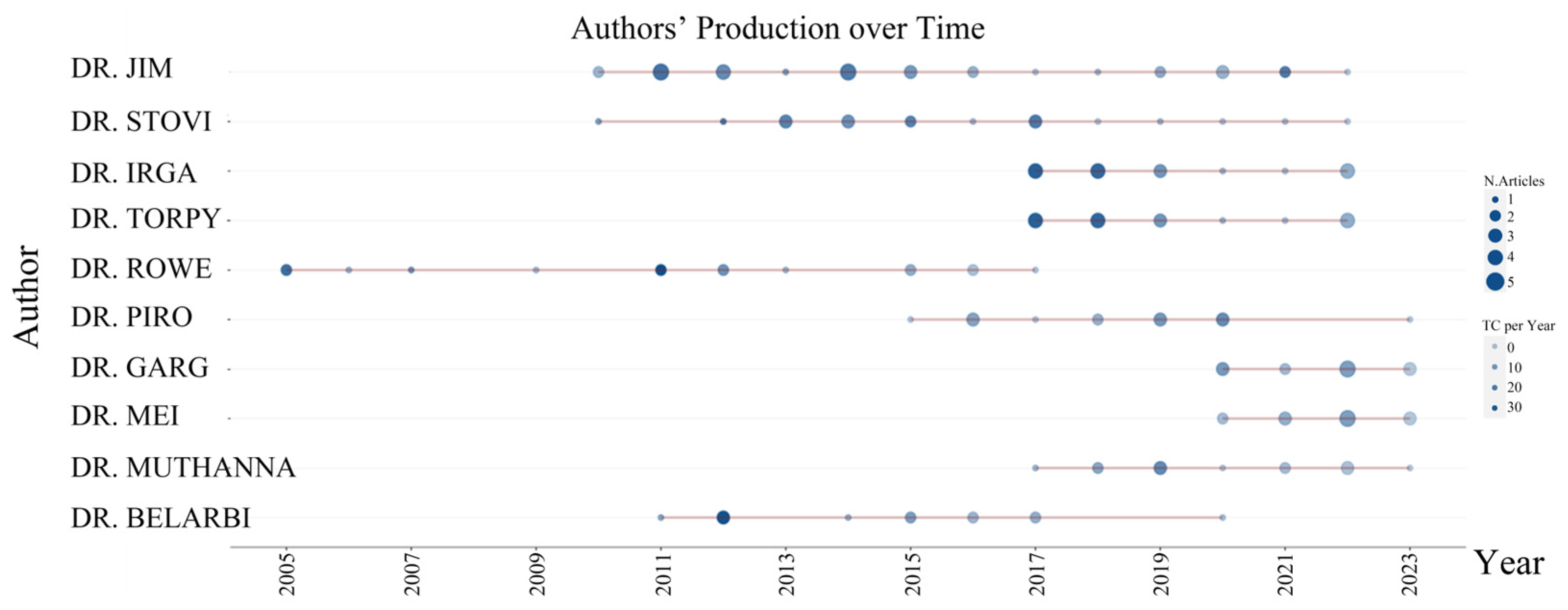
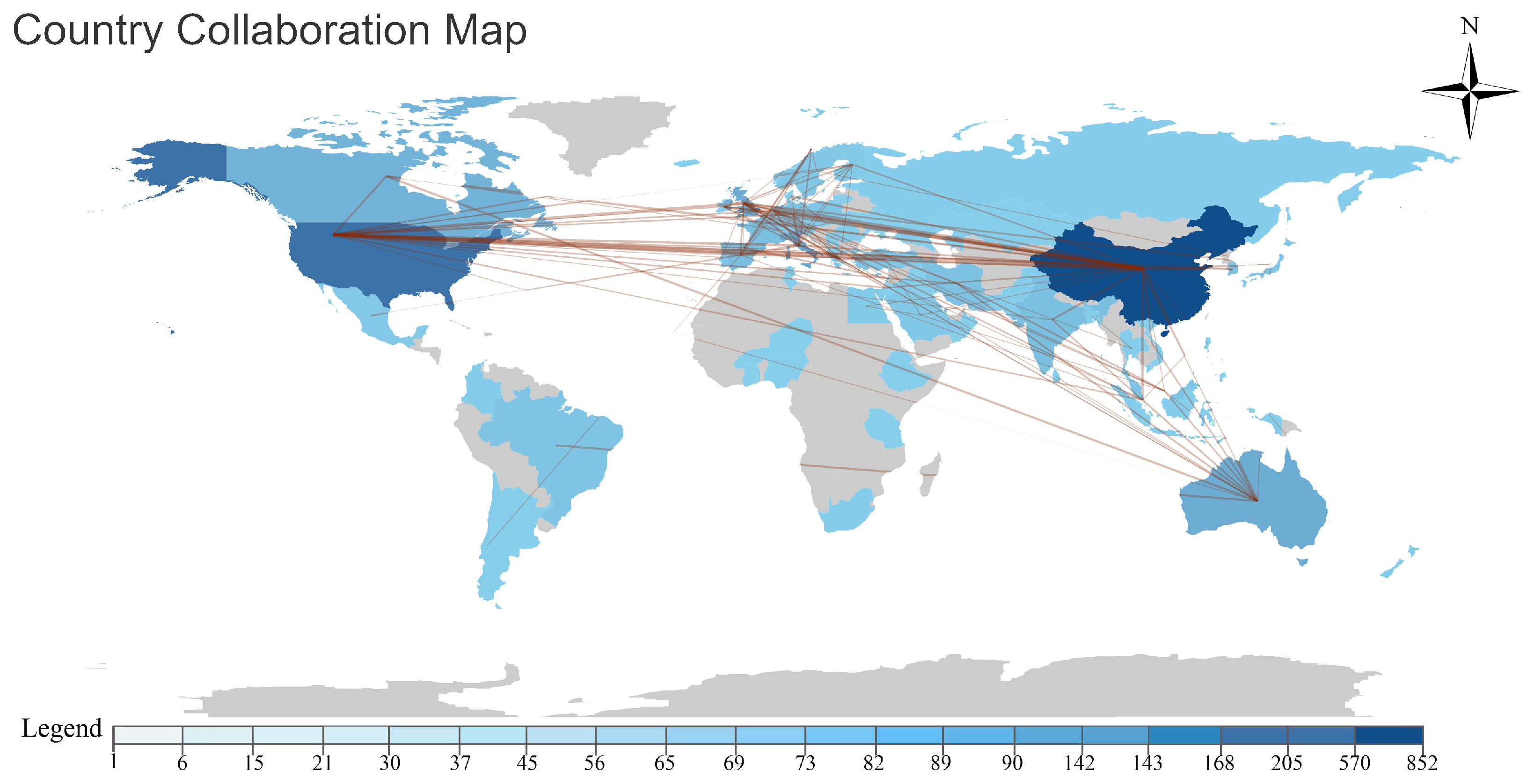
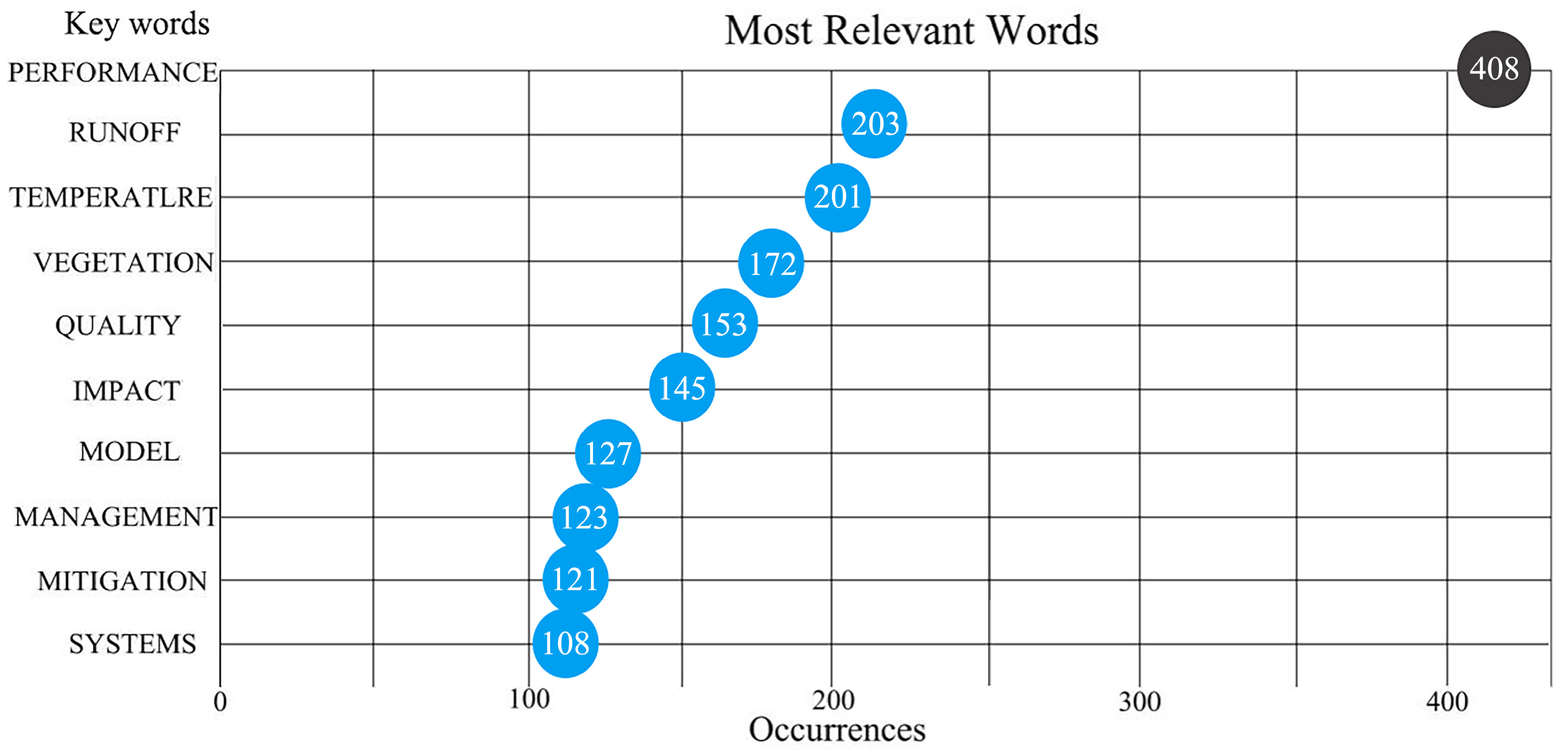
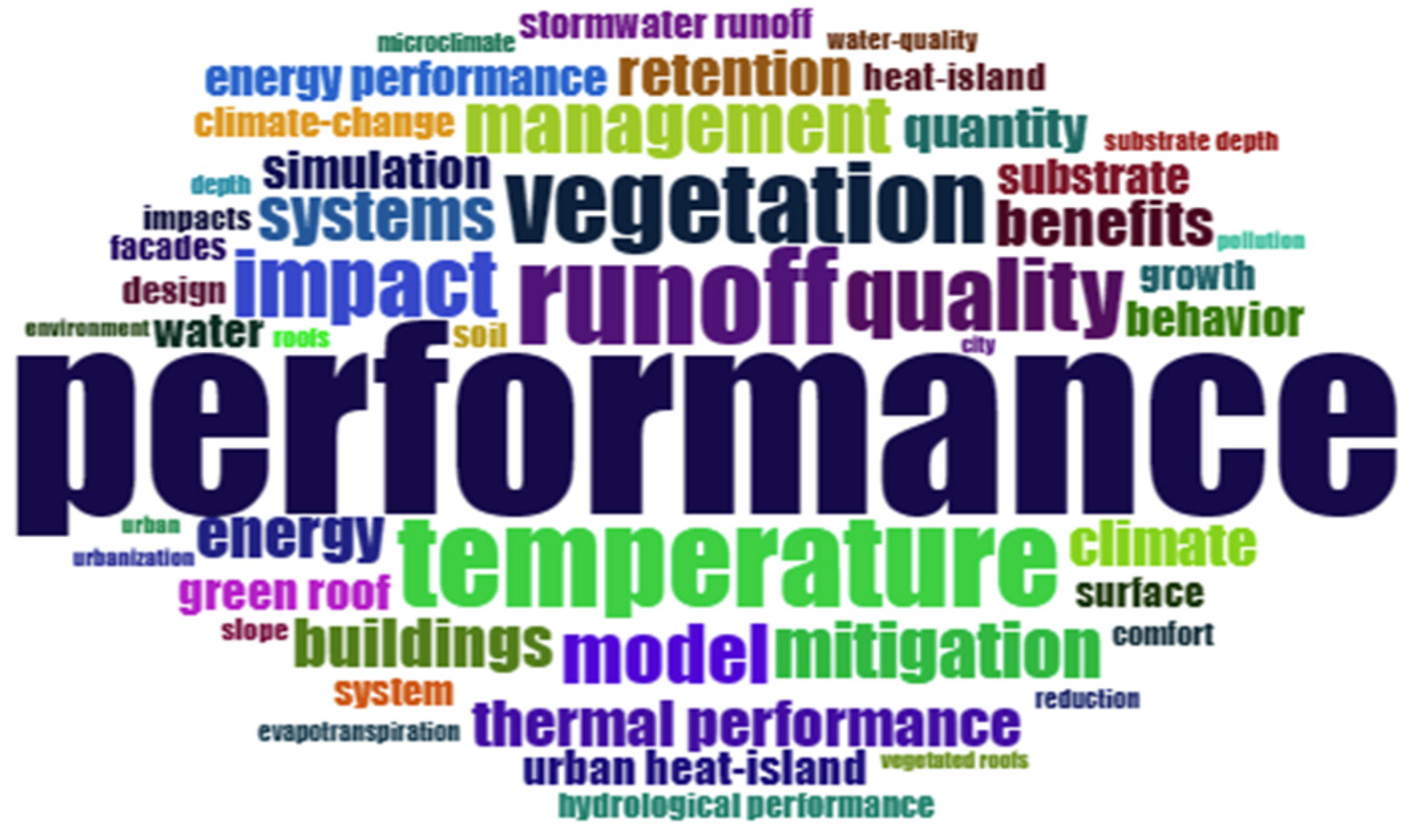
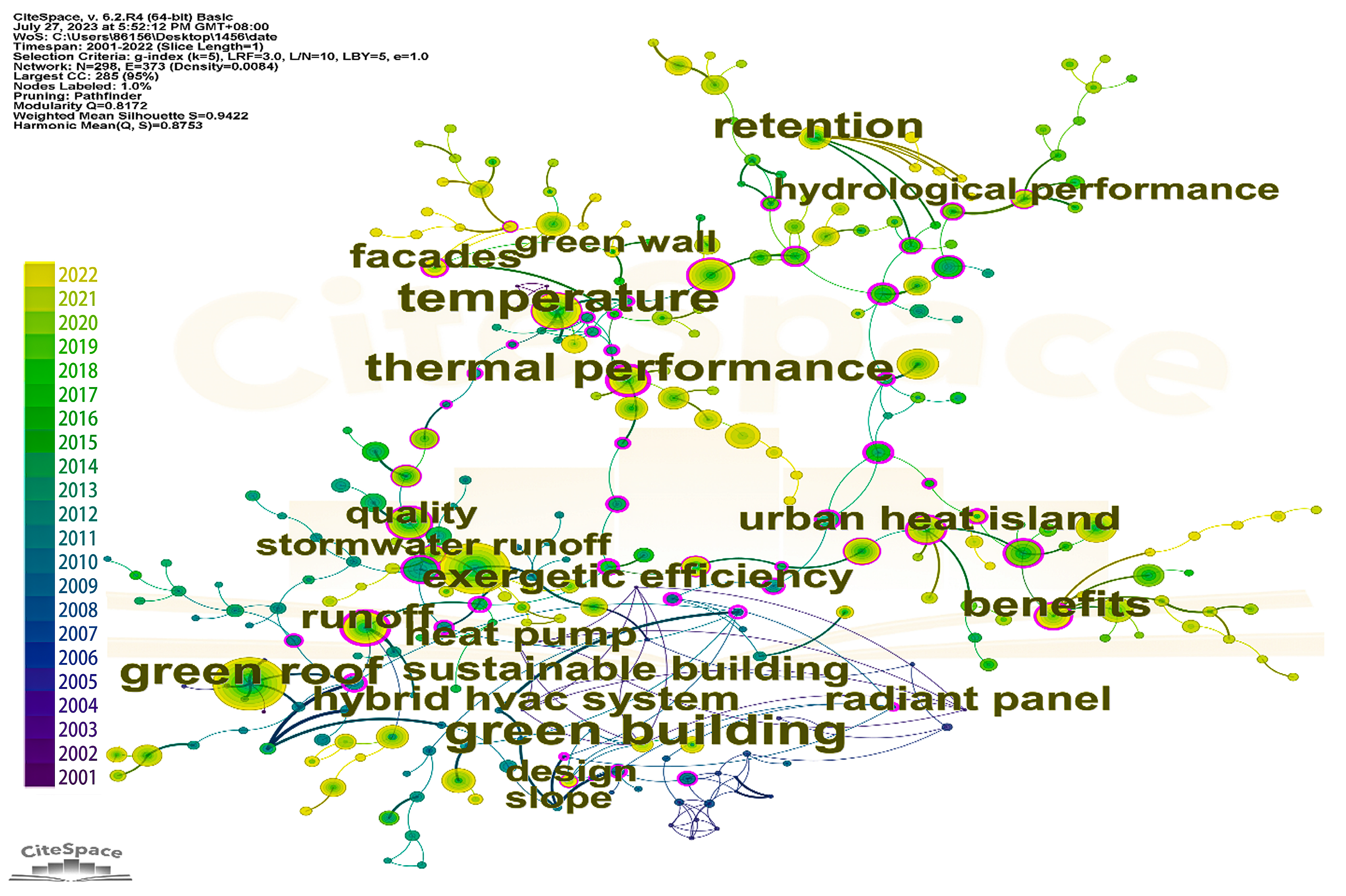
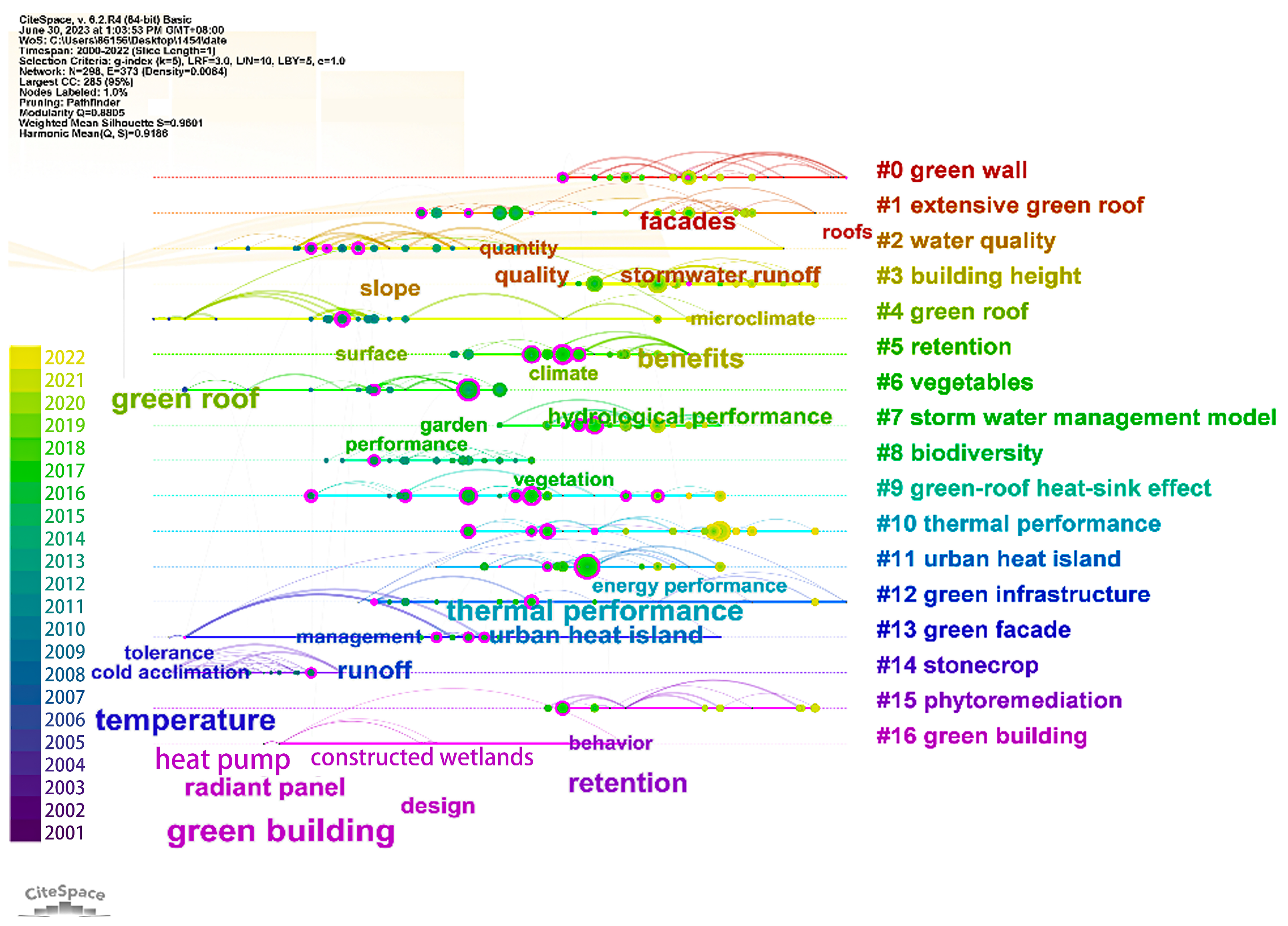

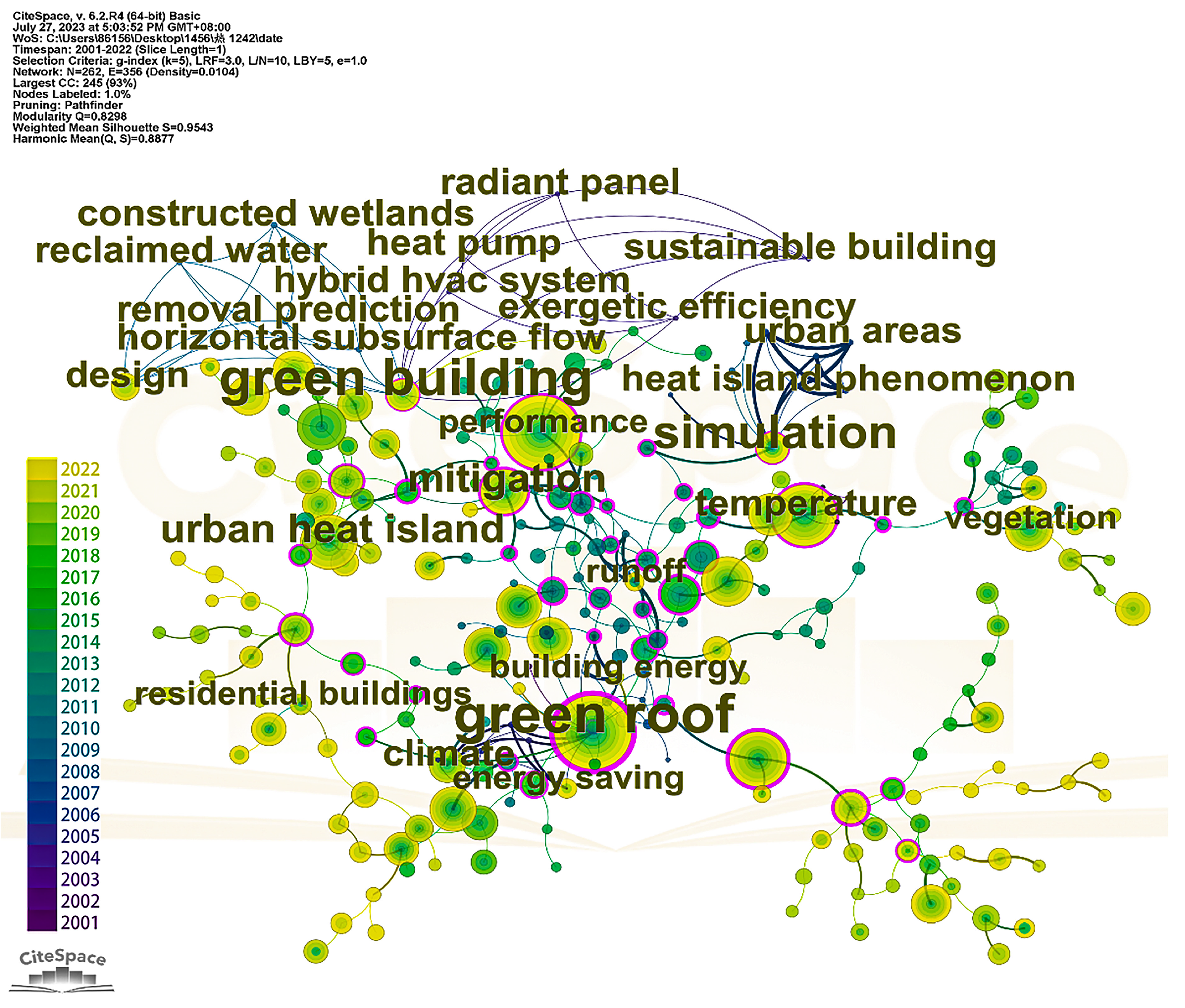
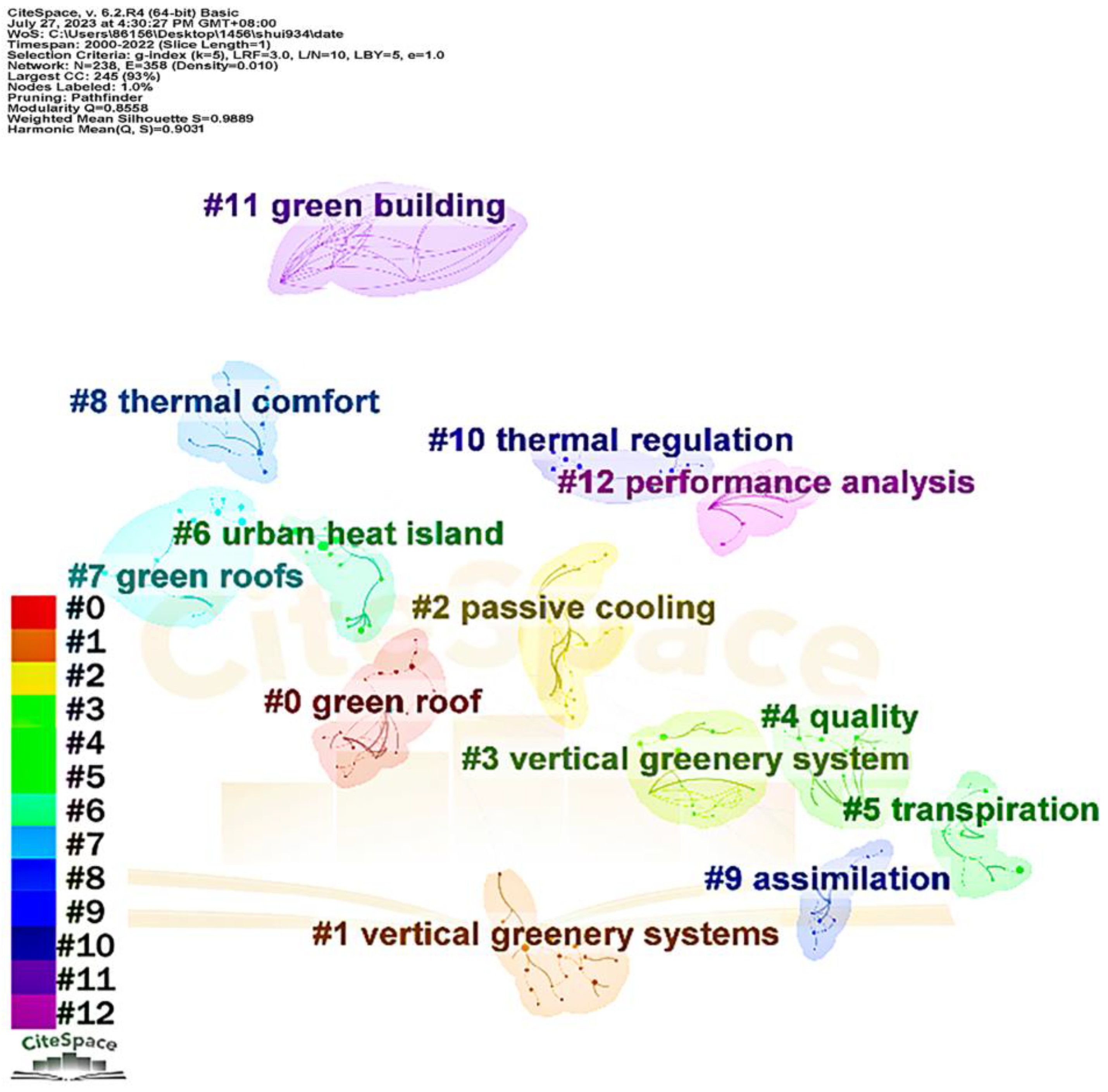



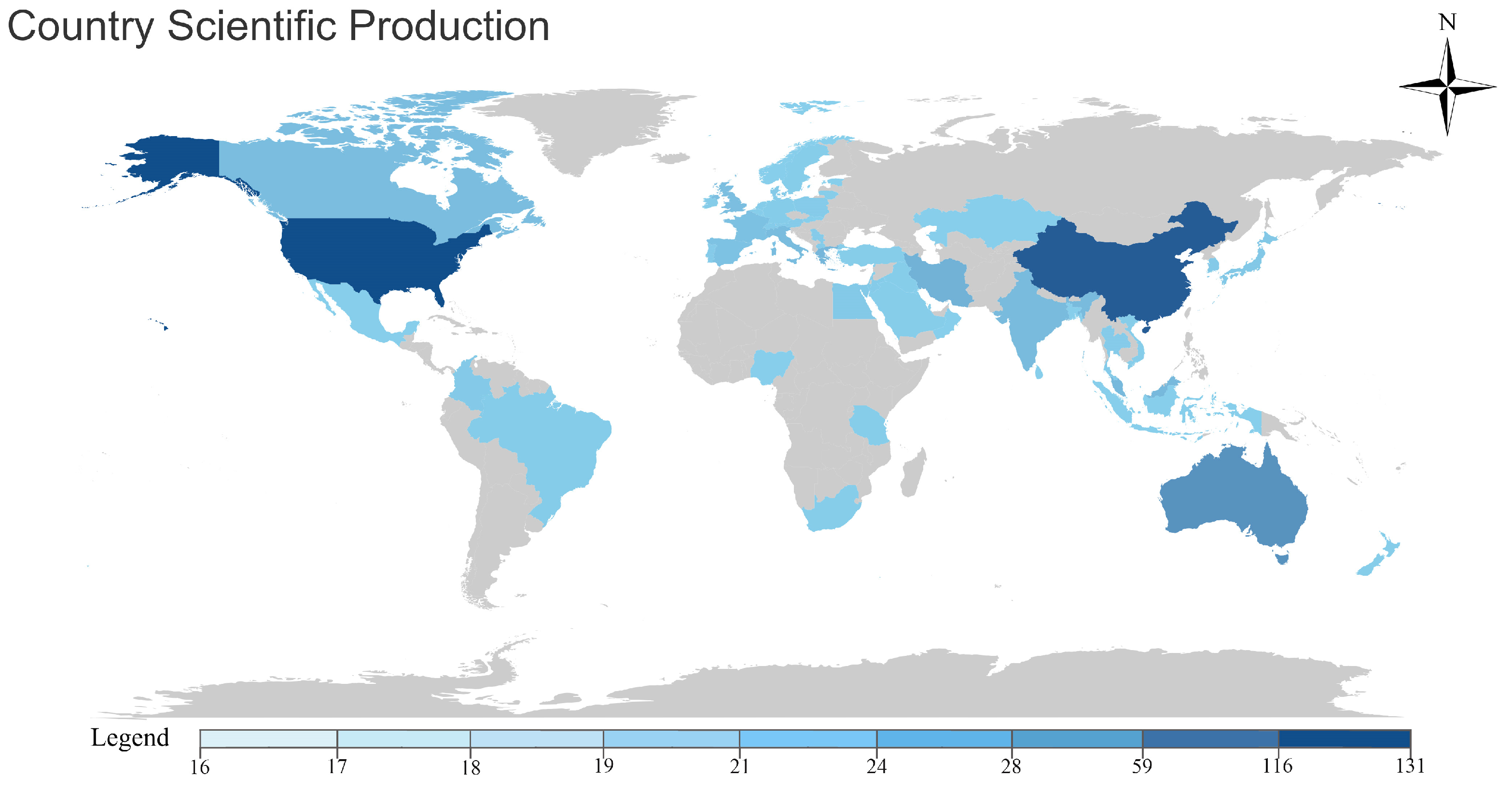
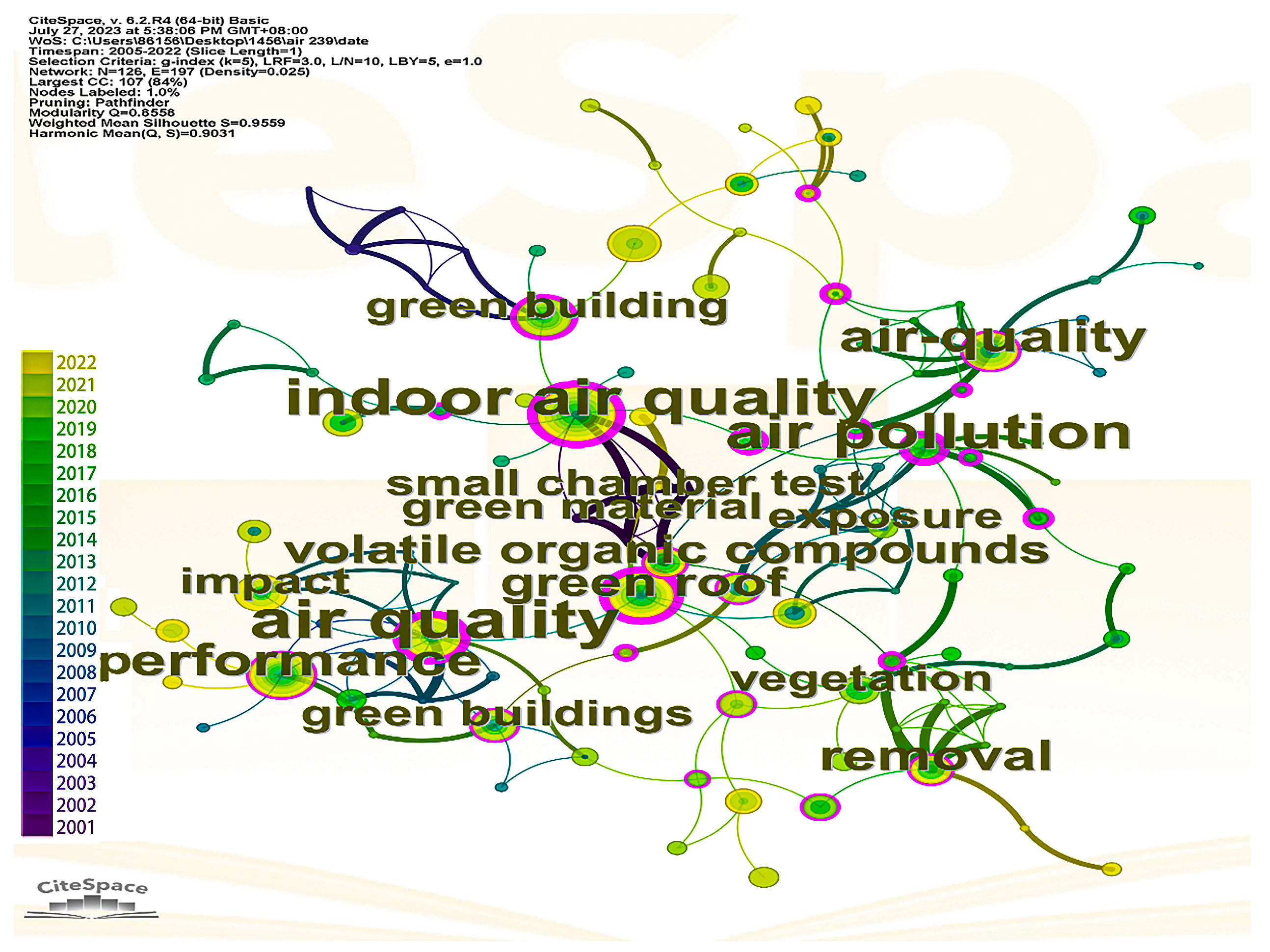
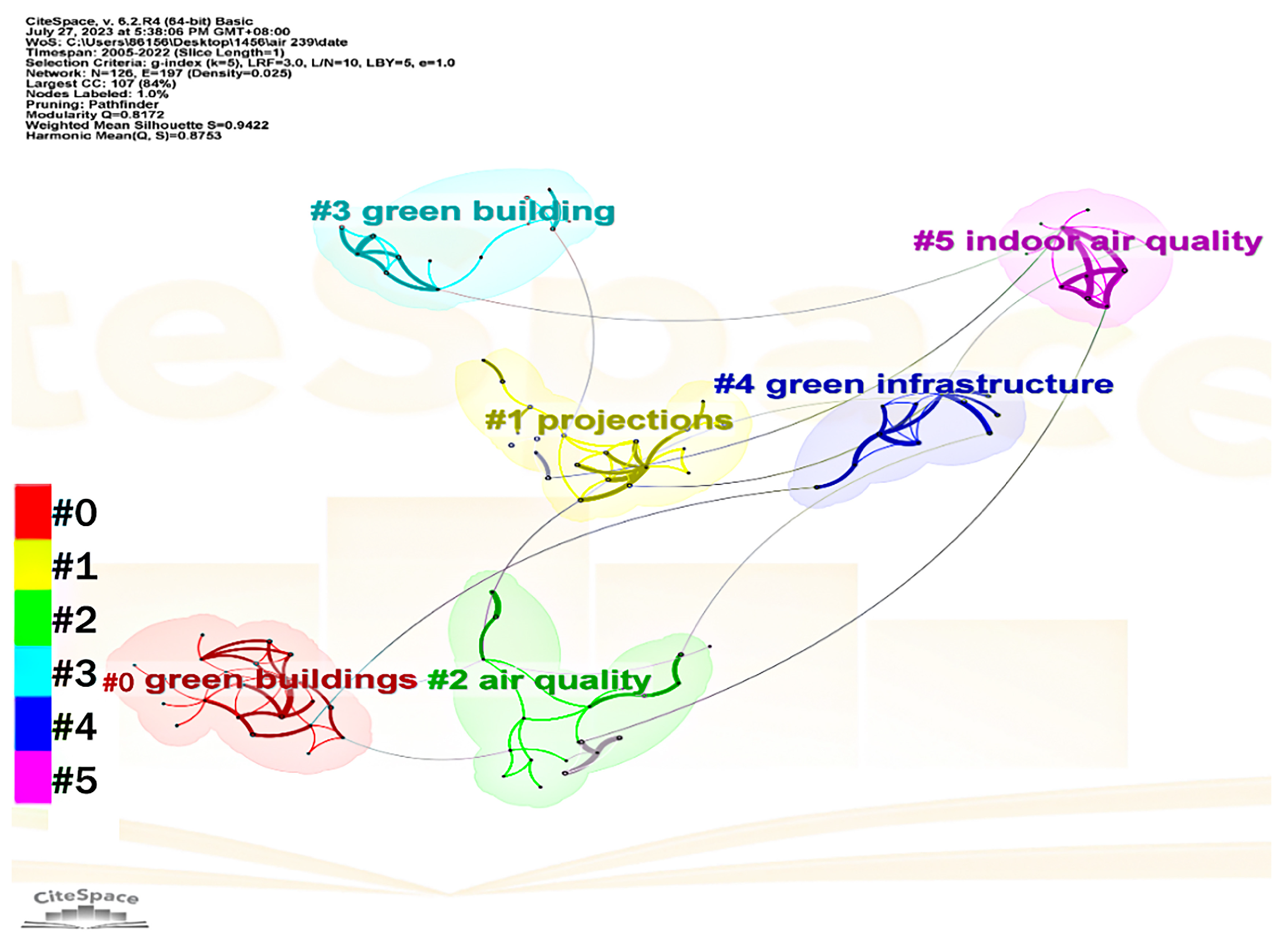
Disclaimer/Publisher’s Note: The statements, opinions and data contained in all publications are solely those of the individual author(s) and contributor(s) and not of MDPI and/or the editor(s). MDPI and/or the editor(s) disclaim responsibility for any injury to people or property resulting from any ideas, methods, instructions or products referred to in the content. |
© 2024 by the authors. Licensee MDPI, Basel, Switzerland. This article is an open access article distributed under the terms and conditions of the Creative Commons Attribution (CC BY) license (https://creativecommons.org/licenses/by/4.0/).
Share and Cite
Zhao, J.; Rao, Q.; Sun, C.; Ikram, R.M.A.; Fan, C.; Li, J.; Wang, M.; Zhang, D. A Systematic Review of the Vertical Green System for Balancing Ecology and Urbanity. Water 2024, 16, 1472. https://doi.org/10.3390/w16111472
Zhao J, Rao Q, Sun C, Ikram RMA, Fan C, Li J, Wang M, Zhang D. A Systematic Review of the Vertical Green System for Balancing Ecology and Urbanity. Water. 2024; 16(11):1472. https://doi.org/10.3390/w16111472
Chicago/Turabian StyleZhao, Jiayu, Qiuyi Rao, Chuanhao Sun, Rana Muhammad Adnan Ikram, Chengliang Fan, Jianjun Li, Mo Wang, and Dongqing Zhang. 2024. "A Systematic Review of the Vertical Green System for Balancing Ecology and Urbanity" Water 16, no. 11: 1472. https://doi.org/10.3390/w16111472
APA StyleZhao, J., Rao, Q., Sun, C., Ikram, R. M. A., Fan, C., Li, J., Wang, M., & Zhang, D. (2024). A Systematic Review of the Vertical Green System for Balancing Ecology and Urbanity. Water, 16(11), 1472. https://doi.org/10.3390/w16111472








